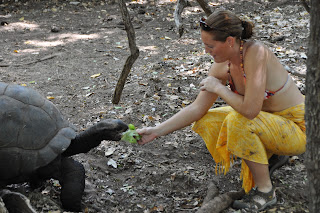Now that I am home and have access to my photos and a much better internet connection, its time to tell you all the step by step process for building a Habitat for Humanity house in Debre Birhan, Ethiopia.
The town of Debre Birhan is quite small and known only for its blanket factory and location on the main road north of Addis Ababa. There are only 2 hotels and if you want something other than local food, you'd better be happy with spaghetti. Luckily the local food is delicious! The government owns all of the land in Ethiopian and permission must be granted to build on it. Habitat for Humanity was granted a large plot of land to build a community on at the west edge of town. Currently there are over 400 homes completed, 80 in progress and plans for many more to come. Each home consists of a small front lawn, which homeowners usually enclose with a fence and plant a garden or enclose animals in, a house and a latrine. Space is also left for a kitchen which most homeowners will add on their own also.
 |
View of the newest section of Habitat for Humanity's Debre
Birhan community. All of these homes were built by Habitat for Humanity |
 |
| Digging foundations for the 2 room house and latrine pit behind |
We started our first day with digging foundations. The local skilled labour had already marked out the size of plot we were to dig and supplied us with a stick that must be the width and depth of the completed trench. The ground in Ethiopia is incredibly dry and hard. Digging foundations requires a pick to break the ground and a shovel to remove it.
Once foundations are dug, the local skilled labourers put up the frame. The frame is constructed of eucalyptus tree poles with a steel roof and supported by filling the foundation with rocks. We did not take part in this. I guess they wanted to make sure it was done right. haha
 |
| A row of houses with foundations almost complete |
The next step is to use smaller pieces of eucalyptus poles to fill the spaces in the walls of the building by weaving wet tree bark from inside to outside around each piece of wood. Once all of the spaces are filled, support poles are added to the building and you weave them into place with the same bark.
 |
| Dave working on building the wall of a house |
The next step is chicka! What will become the front lawn of the house is soaked for several days and straw is left on the top to hold the moisture in. Periodically, workers mix the mud with a pitch fork and with their feet like stomping grapes.
 |
| A worker prepares the chicka |
Once the mix is ready, it is carried into the house and thrown at the walls and smoothed into place. This is definitely the most fun part of our build. It is surprisingly tiring to make mud balls and throw them all day and, of course, there is bound to be a mud fight. Once the mud layer inside the house is dry, it is applied to the outside in the same manner. Then, using a round stick, holes are pushed an inch into the mud to help the cement final layer to stick.
 |
| Carrying chicka to the house |
 |
| Amy and I working on an inside wall |
 |
Making balls on mud to throw to a worker on
a ladder for the tops of the walls. Hard work! |
 |
| Dave, Maria and Xavier having fun with chicka |
Next comes a labour intensive job of raising the floor level inside the house. Carrying rocks and dirt on makeshift gurneys and dumping until the level is high enough. Then tamping down the floor and levelling. The house will have a cement floor, but you must wait 1 year for it to settle first.
Wire mesh is wrapped around the finished house and nailed into place and the skilled labourers are left to do the final concrete application to the inside and outside walls of the house. We did get to help in the concrete process by screening the gravel. Another day of shoveling in the hot sun!
 |
| A bed spring is used to filter the larger rocks out of the cement mix |
 |
Painting on an Ethiopian ladder. This homeowner has put in
her own ceiling made from nylon bags. It wasvery pretty |
Finally, the interior of the house is painted with a mix of 'animal glue and gypsum' as a primer and the house is ready. A dedication ceremony to give the new homeowner their new keys and bible is the final step and one which all members of the community are present for.
Now you can build your own chicka house!































